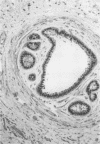Abstract
AIM: To make a quantitative evaluation by image analysis of oestrogen receptors, progesterone receptors, and androgen receptors in papillary hidradenomas and anogenital sweat glands. METHODS: 20 papillary hidradenomas and the anogenital sweat glands detected in surgical specimens selected from 10 vulvectomies for squamous carcinoma, eight haemorrhoidectomies, and one anal polypectomy, all from female patients, were investigated by the avidinstreptavidin peroxidase testing system. RESULTS: 90% of papillary hidradenomas and almost all the anogenital sweat glands showed immunoreactivity for oestrogen receptor and, more weakly, for progesterone receptor, with immunolabelled nuclear area ranging from 10% to 90%. Conversely conventional sweat glands did not show any nuclear staining. Overexpression of androgen receptors occurred in 20% of papillary hidradenomas, with nuclear staining strictly bordering papillary epithelium with apocrine differentiation. There was no immunoreactivity for androgen receptors in anogenital sweat glands. CONCLUSIONS: Oestrogen and progesterone receptors seem to represent reliable markers for differentiating between anogenital sweat glands and conventional sweat glands, and a further link to explain why papillary hidradenomas occur almost exclusively in the female anogenital region. Positivity for oestrogen/progesterone receptors suggests that epithelia either of anogenital sweat glands or of papillary hidradenomas are controlled by ovarian steroid hormones. Androgen receptor nuclear staining of the epithelium with apocrine differentiation in vulvar papillary hidradenoma strengthens its homology with breast duct papilloma.
Full text
PDF



Images in this article
Selected References
These references are in PubMed. This may not be the complete list of references from this article.
- Battifora H. Assessment of antigen damage in immunohistochemistry. The vimentin internal control. Am J Clin Pathol. 1991 Nov;96(5):669–671. doi: 10.1093/ajcp/96.5.669. [DOI] [PubMed] [Google Scholar]
- Choudhry R., Hodgins M. B., Van der Kwast T. H., Brinkmann A. O., Boersma W. J. Localization of androgen receptors in human skin by immunohistochemistry: implications for the hormonal regulation of hair growth, sebaceous glands and sweat glands. J Endocrinol. 1992 Jun;133(3):467–475. doi: 10.1677/joe.0.1330467. [DOI] [PubMed] [Google Scholar]
- Donati P., Amantea A. Adenoma of anogenital mammary-like glands. Am J Dermatopathol. 1996 Feb;18(1):73–76. doi: 10.1097/00000372-199602000-00012. [DOI] [PubMed] [Google Scholar]
- Lloveras B., Googe P. B., Goldberg D. E., Bhan A. K. Estrogen receptors in skin appendage tumors and extramammary Paget's disease. Mod Pathol. 1991 Jul;4(4):487–490. [PubMed] [Google Scholar]
- MEEKER J. H., NEUBECKER R. D., HELWIG E. B. Hidradenoma papilliferum. Am J Clin Pathol. 1962 Feb;37:182–195. doi: 10.1093/ajcp/37.2.182. [DOI] [PubMed] [Google Scholar]
- Nenci I., Beccati M. D., Pagnini C. A. Estrogen receptors and post-receptor markers in human breast cancer: a reappraisal. Tumori. 1978 Apr 30;64(2):161–174. doi: 10.1177/030089167806400206. [DOI] [PubMed] [Google Scholar]
- Shikata N., Kurokawa I., Andachi H., Tsubura A. Expression of androgen receptors in skin appendage tumors: an immunohistochemical study. J Cutan Pathol. 1995 Apr;22(2):149–153. doi: 10.1111/j.1600-0560.1995.tb01398.x. [DOI] [PubMed] [Google Scholar]
- Simon K. E., Dutcher J. P., Runowicz C. D., Wiernik P. H. Adenocarcinoma arising in vulvar breast tissue. Cancer. 1988 Nov 15;62(10):2234–2238. doi: 10.1002/1097-0142(19881115)62:10<2234::aid-cncr2820621027>3.0.co;2-f. [DOI] [PubMed] [Google Scholar]
- Swanson P. E., Mazoujian G., Mills S. E., Campbell R. J., Wick M. R. Immunoreactivity for estrogen receptor protein in sweat gland tumors. Am J Surg Pathol. 1991 Sep;15(9):835–841. doi: 10.1097/00000478-199109000-00003. [DOI] [PubMed] [Google Scholar]
- Wallace M. L., Longacre T. A., Smoller B. R. Estrogen and progesterone receptors and anti-gross cystic disease fluid protein 15 (BRST-2) fail to distinguish metastatic breast carcinoma from eccrine neoplasms. Mod Pathol. 1995 Dec;8(9):897–901. [PubMed] [Google Scholar]
- Wallace M. L., Smoller B. R. Progesterone receptor positivity supports hormonal control of syringomas. J Cutan Pathol. 1995 Oct;22(5):442–445. doi: 10.1111/j.1600-0560.1995.tb00760.x. [DOI] [PubMed] [Google Scholar]
- Woodworth H., Jr, Dockerty M. B., Wilson R. B., Pratt J. H. Papillary hidradenoma of the vulva: a clinicopathologic study of 69 cases. Am J Obstet Gynecol. 1971 Jun 15;110(4):501–508. doi: 10.1016/0002-9378(71)90691-0. [DOI] [PubMed] [Google Scholar]
- van der Putte S. C. Anogenital "sweat" glands. Histology and pathology of a gland that may mimic mammary glands. Am J Dermatopathol. 1991 Dec;13(6):557–567. [PubMed] [Google Scholar]






